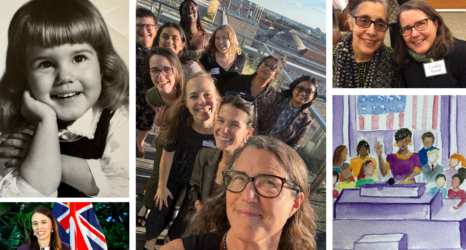“One woman can make a difference, but it is easier if we do it in groups.” That was the motto of the National Coalition of Women’s Organizations.
Holding together a large and diffuse coalition is a challenge for any movement. Political organizing in the United States has become more specific and less broad. Coalitions, however, work against this grain. Coalitions bring diverse groups together who live and breathe separate, yet often overlapping and sometimes redundant, existences.
My book—Push Back, Move Forward, which came out in September—is a study of a shifting coalition of mouthy women who stood up, showed up and acted out. My study of the NCWO echoes and builds on social movement scholarship and public policy analysis. A national coalition like the NCWO was part and parcel of long civil rights, labor and women’s movements. It was intersectional and aware of the dominant power dynamics of well-resourced individuals, groups and interests who might have disproportionate influence within a coalition. The efforts of groups and coalitions like the NCWO were foundational, yet often uncelebrated, as they seemed unspectacular.
Push Back, Move Forward is based on fieldwork conducted from 1999 to 2001 and again from 2008 through 2014. From 1999 to 2014, I attended 25 NCWO meetings, which were held every other month in Washington, D.C. I also conducted 69 interviews with individuals involved with the NCWO. While doing fieldwork in D.C., I was invited along when NCWO members attended events and meetings. My participant observations at more than 47 demonstrations, press conferences, congressional committee hearings, NCWO-sponsored trainings and NCWO task force meetings also inform the research.
In addition to fieldwork, I followed the political activities of the NCWO through their email announcements, policy statements and position papers. In the summer of 2011, I was given access to the files in the NCWO offices in D.C. and authorized to copy relevant documents, communications and reports. One step feminist researchers try to take in their work is to give back to the group or people being studied; my small gesture of giving back for the kindnesses of the busy people in the NCWO coalition was to make a catalog or a list of the contents of their files, organize and box them up when appropriate and leave the NCWO office with better organized archives than they had when I started.
Feminist scholars, as is well known, “frequently engage in participant observation.” As Tickner wrote in 2014: “They are generally suspicious of Cartesian ways of knowing, or the High Science model, which depicts human subjects as solitary and self-subsistent and where knowledge is obtained through measurement rather than sympathy.”
Feminist methods also situate the researcher in the research process; researchers periodically need to critically reflect on the power and powerlessness of the researcher in the project. As Gloria Steinem explained about the wisdom of many women: “Never having learned to separate mind and body, thoughts and emotion or intellect from the senses, they trusted their own experience.”
The NCWO sought to empower girls and women as effective advocates for their visions and dreams. For many years, the NCWO held an annual conference called WESCAD—Women’s Equality Summit and Congressional Action Day. Each year, attendees were provided with advice from experienced speakers on how to effectively and succinctly advocate for issues on the Hill. In each training session I observed, demystifying politics was a powerful part of the lesson.
In 2008, Lisa Maatz, a widely respected policy advocate and strategist at the American Association of University Women, told the gathering at WESCAD how to frame an issue, pose an “ask,” provide data and research and then close the deal with a story about a real person. “Your voice can make a difference,” Maatz admonished. “The best tool in your arsenal is a personal story, not the statistics. Tell your story. Let them put a face to the issue. Real people. How it works in the district.”
Eleanor Smeal, president of the Feminist Majority Foundation, followed this model, too. She told young people preparing for their summer internships on Capitol Hill that they were all smart, and she could demystify the federal budget for them. Planning sessions I observed regarding proposed reforms to Social Security or health care reform went through similar steps. The last step, to cinch the point, was to find a “real person” to provide a narrative story about the impact events were having on them.
In Push Back, Move Forward, I utilized stories about real people. It is part of the ethos in women’s politics to break silences and honor women’s experiences. When telling stories, I heeded the advice of battle-hardened advocates like Maatz and Smeal.
When the meaning of a story is grasped, so are its moral implications. The final step should be to link individual narratives to public policies so everyone with similar stories can access resources to relieve their hardships.
Material drawn from “Introduction: Easier in Groups; The American Women’s Movement and the National Council of Women’s Organizations” from Push Back, Move Forward: The National Council of Women’s Organizations and Coalition Advocacy by Laura R. Woliver. Used by permission of Temple University Press. © 2018 by Temple University. All Rights Reserved.





